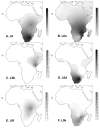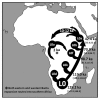The first modern human dispersals across Africa
- PMID: 24236171
- PMCID: PMC3827445
- DOI: 10.1371/journal.pone.0080031
The first modern human dispersals across Africa
Abstract
The emergence of more refined chronologies for climate change and archaeology in prehistoric Africa, and for the evolution of human mitochondrial DNA (mtDNA), now make it feasible to test more sophisticated models of early modern human dispersals suggested by mtDNA distributions. Here we have generated 42 novel whole-mtDNA genomes belonging to haplogroup L0, the most divergent clade in the maternal line of descent, and analysed them alongside the growing database of African lineages belonging to L0's sister clade, L1'6. We propose that the last common ancestor of modern human mtDNAs (carried by "mitochondrial Eve") possibly arose in central Africa ~180 ka, at a time of low population size. By ~130 ka two distinct groups of anatomically modern humans co-existed in Africa: broadly, the ancestors of many modern-day Khoe and San populations in the south and a second central/eastern African group that includes the ancestors of most extant worldwide populations. Early modern human dispersals correlate with climate changes, particularly the tropical African "megadroughts" of MIS 5 (marine isotope stage 5, 135-75 ka) which paradoxically may have facilitated expansions in central and eastern Africa, ultimately triggering the dispersal out of Africa of people carrying haplogroup L3 ~60 ka. Two south to east migrations are discernible within haplogroup LO. One, between 120 and 75 ka, represents the first unambiguous long-range modern human dispersal detected by mtDNA and might have allowed the dispersal of several markers of modernity. A second one, within the last 20 ka signalled by L0d, may have been responsible for the spread of southern click-consonant languages to eastern Africa, contrary to the view that these eastern examples constitute relicts of an ancient, much wider distribution.
Conflict of interest statement
Figures






Similar articles
-
The Expansion of mtDNA Haplogroup L3 within and out of Africa.Mol Biol Evol. 2012 Mar;29(3):915-27. doi: 10.1093/molbev/msr245. Epub 2011 Nov 16. Mol Biol Evol. 2012. PMID: 22096215
-
Human origins in a southern African palaeo-wetland and first migrations.Nature. 2019 Nov;575(7781):185-189. doi: 10.1038/s41586-019-1714-1. Epub 2019 Oct 28. Nature. 2019. PMID: 31659339
-
Whole-mtDNA genome sequence analysis of ancient African lineages.Mol Biol Evol. 2007 Mar;24(3):757-68. doi: 10.1093/molbev/msl209. Epub 2006 Dec 28. Mol Biol Evol. 2007. PMID: 17194802
-
African human mtDNA phylogeography at-a-glance.J Anthropol Sci. 2011;89:25-58. doi: 10.4436/jass.89006. Epub 2011 Mar 15. J Anthropol Sci. 2011. PMID: 21368343 Review.
-
Bantu-speaker migration and admixture in southern Africa.Hum Mol Genet. 2021 Apr 26;30(R1):R56-R63. doi: 10.1093/hmg/ddaa274. Hum Mol Genet. 2021. PMID: 33367711 Free PMC article. Review.
Cited by
-
Genetic stratigraphy of key demographic events in Arabia.PLoS One. 2015 Mar 4;10(3):e0118625. doi: 10.1371/journal.pone.0118625. eCollection 2015. PLoS One. 2015. PMID: 25738654 Free PMC article.
-
Mitochondrial Haplogroup Influences Motor Function in Long-Term HIV-1-Infected Individuals.PLoS One. 2016 Oct 6;11(10):e0163772. doi: 10.1371/journal.pone.0163772. eCollection 2016. PLoS One. 2016. PMID: 27711166 Free PMC article.
-
Evolutionary analysis of Mycobacterium bovis genotypes across Africa suggests co-evolution with livestock and humans.PLoS Negl Trop Dis. 2020 Mar 2;14(3):e0008081. doi: 10.1371/journal.pntd.0008081. eCollection 2020 Mar. PLoS Negl Trop Dis. 2020. PMID: 32119671 Free PMC article.
-
Rectifying long-standing misconceptions about the ρ statistic for molecular dating.PLoS One. 2019 Feb 19;14(2):e0212311. doi: 10.1371/journal.pone.0212311. eCollection 2019. PLoS One. 2019. PMID: 30779770 Free PMC article.
-
Searching for the roots of the first free African American community.Sci Rep. 2020 Nov 26;10(1):20634. doi: 10.1038/s41598-020-77608-8. Sci Rep. 2020. PMID: 33244039 Free PMC article.
References
-
- Gamble C (2007) Origins and revolutions: human identity in earliest prehistory. Cambridge University Press.
-
- Stringer C (2011) The origin of our species: Penguin.
Publication types
MeSH terms
Substances
LinkOut - more resources
Full Text Sources
Other Literature Sources

